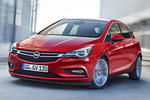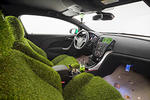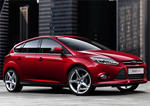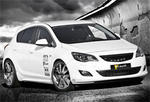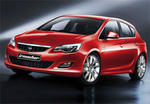
Opel released the details of their new Astra Sedan - the Opel Astra Notchback. For the Opel Astra Notchback there is an option between two petrol engines and two diesel ones: a 1.6 liter ECOTEC engine developing 115 hp and 155 Nm of torque, a 1.8 liter ECOTEC engine developing 140 hp and 175 Nm of torque, a 1.3 CDTI ECOTEC developing 90 hp and 200 Nm of torque and a 1.7 CDTI ECOTEC diesel engine developing 100 hp and 240 Nm of torque.
Opel Press Release:
New Opel Astra Notchback
Elegant and Roomy Four-Door Sedan for Growing Markets
- Refined technology package for top agility and precise handling
- Central and Eastern Europe: Additional body style for successful Astra range
- Production at Gliwice plant in Poland began on August 23
- Turkey and Russia most important markets with one-third of sales respectively
Antalya. With the elegant four-door Astra sedan, Opel expands its bestselling Astra range to seven models. The new variant, which had its world premiere at the Istanbul Motor Show in November 2006,


complements the five-door hatch, station wagon, three-door GTC, OPC, cabrio-coupé TwinTop and van variants. Based on the station wagon’s long wheelbase, the new Astra sedan boasts great driving dynamics combined with high safety reserves. Its four engines from 90 to 140 horsepower will be an important addition to the line-up, particularly in the strong, thriving markets in Central and Eastern Europe. 67 percent of Turkish customers who purchase a compact class car choose a notchback model. In Russia, this figure is 65 percent. Opel expects to sell about one-third of Astra sedans in Russia and Turkey respectively. A further ten percent each will go
to Spain and Southeast Europe. The new Astra sedan is scheduled to be launched this month.
The automotive landscape in Europe is changing rapidly: In just five years, from 2002 to 2007, sales in Central and Eastern Europe have more than doubled. While in 2002, just 2.7 million cars were sold in this region, this figure is expected to rise to more than 5.5 million by the end of the year. Over the same period, GM’s market share has more than doubled from 4.35 percent to 8.9 percent, and with the launch of the new Astra sedan, further share growth is anticipated through years-end.
Overall, the addition of the notchback model will give the highly successful Astra line-up, of which 517,000 were sold across Europe in 2006, a further push in 2008. By the end of calendar year 2007, Opel expects to sell more Astras in Central and Eastern Europe than Germany, pushing this region into second place behind the United Kingdom. With the notchback model riding high in registration statistics, Central and Eastern Europe looks likely to move into number one spot in Astra sales in 2008.
Opel continues a tradition with the new Astra notchback model, as the first two Astra generations were both available with four doors and a large, separate luggage compartment. The first new Astra sedan rolled off the production
line on August 23 in Gliwice, Poland – an ideal location to serve the Central and Eastern European markets for which the car has been primarily developed. The predecessor notchback model, Astra Classic, will also continue to be built there.
The new sedan boasts the Astra’s progressive, proportionally balanced design, dynamic lines and characteristic driving dynamics, together with high safety reserves. The new model’s designers adopted the long wheelbase from the station wagon (2703 mm) for generous space in the rear and a large luggage compartment. With a length of 4587 mm and luggage compartment volume of 490 liters, the 1753 mm wide and 1458 mm high four-door sedan is positioned as an upper-end family car.
Powertrain and chassis: Four engines, pronounced agility and high safety reserves
Four state-of-the-art ECOTEC gasoline and diesel engines are available for the four-door Astra: two gasoline engines (1.6-liter/115 hp, 1.8-liter/140 hp) and two diesel engines (1.3-liter/90 hp, 1.7-liter/100 hp). The transmission range includes five-speed and six-speed manual gearboxes, a four-speed automatic, as well as an enhanced automated Easytronic manual transmission.
The Astra offers top agility and precise handling with high levels of driving safety, the basis for which is the IDS chassis (Interactive Driving System) with McPherson front axle and patented torsion-beam rear axle. Standard safety features in all Astra variants include front disc brakes, ABS, Cornering Brake Control (CBC), brake assist as well as Electro-Hydraulic Power Steering (EHPS). ESPPlus is optionally available with all models.
Equipment highlights: Advanced technology in compact class
The Astra sedan meets the needs of discerning customers with its extensive range of standard equipment. It also offers optional technology highlights from the Astra's extensive equipment range, such as bi-xenon headlamps, Hill Start Assist (HSA), electric heater “Quickheat” and rear Park Pilot.
The new Astra model is available in three equipment lines: Essentia, Enjoy and Cosmo. The Essentia already boasts important safety features as standard, including front and side airbags as well as ABS and ISOFIX child seat fixtures in the rear. Comfortable and practical standard details include central locking, front power windows, height-adjustable driver’s seat and 60:40 split rear bench seat back. The Astra Enjoy offers even more extensive standard equipment, including air conditioning, heated power mirrors, and
CD-radio CD 30.
The top-of-the-line Cosmo model boasts additional high-quality equipment features such as 16-inch light alloy wheels, two-color door trim, center console in piano black with matt chrome décor moldings and a leather steering wheel with piano black caps.
Body & Design
Full Size Family Sedan with Elegantly Flowing Roofline
Long wheelbase for generous rear leg room and large luggage compartment
The new sedan boasts the Astra’s progressive, proportionally balanced design and dynamic lines. With the latest upgrade of the Astra family of cars earlier this year, designers further honed the distinctive brand face that was first presented in this model line, while ensuring the car is still clearly recognizable as a member of the Astra family. Elements such as the sharply drawn “eyebrows” above the fog lamps serve as a blueprint for future Opel models, while the dynamic V-shaped front is also eye-catching. The headlamp housings in stylish chrome look also convey an additional sense of quality.
Well-balanced proportions are the basis for the harmonious body lines of the Astra sedan. It is based on the station wagon’s long wheelbase, providing a generous 2703 millimeters (90 mm more than hatchback) between the axles and helping to create ample leg room for rear passengers. The new roof line flows elegantly into the tailgate, which turns slightly upward at the end to form an integrated spoiler for optimized aerodynamics. The Astra sedan achieves a drag coefficient of cD = 0.3, resulting in a drag area (cD x A) of 0.68 m².
At 4.59 meters long, 1.75 meters wide and 1.46 meters high, the Astra sedan is a fully grown family sedan with a trunk to match. It offers a luggage compartment volume of 490 liters (VDA standard), which expands to a maximum of 870 liters (measured to the upper edge of the fronts seats with the rear seat backs folded down). Maximum load width is 907 millimeters, with the luggage compartment offering a maximum width of 1170 mm and a maximum length of 995 mm, which can be expanded to 1721 mm.
The new-edition Astra’s interior boasts surfaces with an even more high-quality look and feel. Distinctive design elements in the cockpit include the prominent center console, additional chrome rings for the air conditioning and radio controls, as well as new trim for the doors and instrument panel, which also boasts three-dimensional instruments. The top Cosmo variant features décor trim and inlays made from luxurious piano lacquer surfaces on the center console and steering wheel as standard.
Chassis and powertrain
Economical Engines Combined with Outstanding Roadholding
Wide range: Four engines and four transmissions available
Four state-of-the-art ECOTEC gasoline and diesel engines are available for the four-door Astra: two gasoline engines (1.6 ECOTEC/115 hp, 1.8 ECOTEC/140 hp) and two diesel engines (1.3 CDTI/90 hp, 1.7 CDTI/100 hp). The transmission range includes five-speed and six-speed manual gearboxes, four-speed automatic, as well as an enhanced automated Easytronic manual transmission.
The entry-level 1.6 ECOTEC gasoline engine’s maximum output is 85 kW/115 hp at 6000 rpm. Combined with the five-speed manual transmission, the Astra Sedan accelerates from zero to 100 km/h in 11.7 seconds and reaches a top speed of 191 km/h. The modern weight-optimized unit features cam-phase technology, which varies the two camshafts to correspond to the driving situation via a vane-type hydraulic adjuster. This dynamically adjusts the continuous variable valve timings for the intake and outlet sides in every operating state, further reducing both consumption and emissions. Maximum torque of 155 Nm is delivered at 4000 rpm. Combined fuel consumption with the manual gearbox is 6.6 liters per 100 kilometers. The optional five-speed automated Easytronic transmission, which comes with Hill Start Assist (HSA), further reduces fuel consumption to 6.4 liters. The ESPPlus-based HSA system makes starting the car on an uphill gradient easier by preventing the car from rolling backwards without the use of the handbrake. After releasing the brake pedal, pressure in the system is maintained for 1.5 seconds, giving the driver enough time to select a gear and press the accelerator. It also prevents the car from rolling forwards when attempting to drive backwards up a hill.
The top-of-the-line 1.8-liter, 103 kW/140 hp gasoline engine promises plenty of driving fun. In order to optimize consumption and performance, this high-tech engine also operates with two variable camshafts, just like its smaller brother.
With a power output per liter of 57 kW, the 1.8 ECOTEC engine is one of the most powerful in this displacement class. Ninety percent of the 175 Nm maximum torque is available over a wide range from 2200 to 6200 rpm, which ensures lively performance even at low engine speeds for relaxed driving.
In combination with the five-speed manual gearbox, the Astra 1.8 accelerates from zero to 100 km/h in 10.2 seconds and reaches a top speed of 207 km/h. Combined fuel consumption is 7.4 liters per 100 kilometers. With the optional four-speed automatic transmission, maximum speed is 188 km/h and acceleration from zero to 100 km/h takes 11.4 seconds. Combined fuel consumption is 7.8 liters per 100 kilometers.
Low fuel consumption is a trademark of modern Opel diesels. At market launch, the new Astra Sedan is available with the very compact 1.3 CDTI ECOTEC with 66 kW/90 hp and maximum torque of 200 Nm at between 1750 and 2500 rpm. The multi-injection unit features variable geometry turbocharging and intercooling. The new Sedan with the
90 hp, 1.3 CDTI engine needs only 5.1 liters of fuel per 100 kilometers (combined). With its standard six-speed gearbox, the Astra 1.3 CDTI reaches 172 km/h and accelerates from zero to 100 km/h in 13.7 seconds.
Fuel supply to the multi-injection system with five nozzles is controlled by a solenoid valve. The injection system is characterized by minimal response time (max. pressure 1600 bar), resulting in extremely fine fuel atomization and up to five injections per cycle. This not only ensures exceptionally economical consumption and favorable emissions values, but also refined and low-noise operation. For example, a pre-injection during the warm-up period reduces cold-start knock to a barely perceptible level. This engine, the world’s most compact four-cylinder common-rail diesel unit with turbocharger and named “Engine of the Year 2005” by the media (length/width/height: 460/500/650 mm), is equipped with a lightweight aluminum cylinder head and a weight-optimized grey cast iron engine block. The four-valve engine’s two overhead camshafts are powered by a cog-belt drive and activate the valves via roller cam followers.
Shortly following its market launch, the Astra Sedan will be available in a more powerful version with a new 1.7-liter common-rail diesel power unit with 74 kW/100 hp. The
1.7 CDTI has a variable-turbocharger and develops a maximum torque of 240 Nm. The 1.7 CDTI engine comes with a six-speed gearbox.
The Astra offers top agility and precise handling with high levels of driving safety. The new Sedan’s IDS suspension (Interactive Driving System) is designed and tuned for exceptional agility and a high level of active safety.
Major contributions are made by the ESPPlus (Electronic Stability Program) and enhanced McPherson front suspension with hydroformed subframe. The latter provides increased driving comfort thanks to decoupled support bearings and weight-dependent spring rates. The rear wheels are on a specifically adapted torsion-beam axle with double-walled U-pattern section. This construction combines the advantages of conventional wishbone axles like reduced space requirements, lower weight and high chamber thrust rate, with the ability to make exact adjustments to the very specific requirements of various models within the model range. In manufacturing the torsion beam axle, the patented Magnetarc welding technique is used. This makes various wall thicknesses possible for the torsion profile (stabilizing effect against sideways tendencies) and various angling tendencies in the profile cross-section (control and self-steering effects).
Standard safety features in all Astra variants include front and rear disc brakes (ventilated in front), ABS, Cornering Brake Control (CBC), brake assist, as well as the fuel-saving Electro-Hydraulic Power Steering (EHPS). This energy-saving hydraulic pump, which is activated by an electric motor, is only used when needed, thereby reducing fuel consumption.
Cornering Brake Control (CBC) optimizes braking distance and driving stability, also when braking in curves. When wheel sensors register different wheel rpm right and left in a curve, braking force at the inner wheels is reduced while brake pressure is applied under the ABS limit. This creates torque that stabilizes the vehicle. Brake assist is a sub-function of the brake booster. It progressively generates the maximum braking pressure if the brake pedal is pressed particularly quickly, thus reducing the braking distance.
Standard wheel size is 6.5 x 15 with tires 195/65 R 15-91 H. 6.5 x 16 wheels with 205/55 R 16-91 H tires are available as an option for all models. Gasoline versions can also be fitted with 215/45 R 17-91 V tires on 7J x 17 wheels.
Available as Essentia, Enjoy and Cosmo
Comprehensive Standard Equipment Includes High-Value Features
Four optional packages allow for even greater personalization
The Astra sedan meets the needs of discerning customers with its extensive range of standard equipment. It also offers optional technological highlights from the Astra's extensive equipment range, such as bi-xenon headlamps, Hill Start Assist (HSA), electric heater “Quickheat” and rear Park Pilot.
The new Astra model is available in three equipment lines: Essentia, Enjoy and Cosmo. The Essentia already boasts important safety features as standard, including front and side airbags, as well as ABS and ISOFIX child seat anchors in the rear. Comfortable and practical standard details include central locking, front power windows, height-adjustable driver’s seat and the 60:40 split rear bench seat back. The Astra Enjoy offers even more extensive standard equipment, including air conditioning, heated power mirrors and
CD-Radio CD 30.
The top-of-the-line Cosmo model boasts additional high-quality equipment features such as 16-inch alloy wheels, two-color door trim, center console in piano black with the décor moldings on matt chrome, and a leather steering wheel with piano black caps.
The newest addition to the Astra family can be further personalized with a selection of four equipment packages:
- Visibility and Light (windshield wipers with rain sensor, automatic photochromatic rear-view mirror, utomatic Lighting Control ALC)
- Winter (heated seats in front, headlamp washer system)
- Seat Comfort (adjustable lumbar support for driver’s seat)
- Leather Seats (in addition to Seat Comfort package: front sport seats, heated front seats)
As an alternative to air conditioning, which is standard from the Enjoy variant, automatic air conditioning and Electronic Climate Control (ECC) with Air Quality Sensor (AQS) are available. The extensive range of infotainment systems is typical of the Astra, with equipment that includes a navigation system or MP3 capability. A mobile phone console with Bluetooth interface and voice control is also available, as well as a Twin Audio system that provides separate entertainment for the rear seats.
Production and quality
Excellent Reputation for Quality
Together with the Zafira and Astra Classic, the new Astra sedan is the third model currently being produced in Gliwice. General Motor’s Gliwice plant, which started production in 1998, has earned an excellent reputation for quality, and is considered a model for new GM manufacturing plants in the world. GM Poland Managing Director Romuald Rytwiński sees the production of the new Astra sedan in Gliwice as a confirmation of the plant’s outstanding quality and workmanship: “As one of the most popular models in the Opel range in Eastern and Central Europe, we are proud to produce the new Astra sedan here in Gliwice, and we are committed to the high levels of quality we expect from our employees and our vehicles.”
Like all other GM plants, the Gliwice plant follows General Motors’ Global Manufacturing System (GM GMS). The system is based on five key concepts: Built-in-Quality, Standardization, Continuous Improvement, Short Lead Time and People Involvement, including shared responsibility for quality management.
The GM Global Manufacturing System is an important building block of an integrated strategy to develop products that excite customers in markets around the world. GM is bringing together the best, most competitive manufacturing practices from around the world and leveraging what it has learned as it moves to a common global manufacturing system for all of its new plants and existing facilities. When implemented, the GMS principles maximize performance in the areas of people systems, safety, quality, customer responsiveness and cost.
At the heart of the system is the operator in the plant - the person who builds the vehicles. Plants and processes are designed around providing support for the operators and teams on the plant floor, so they can efficiently build great vehicles that provide customers with top quality, value and responsiveness.
In accordance with the GM Global Manufacturing System, every employee on the production line in Gliwice has the obligation to pull the ANDON cord if a problem occurs. The Quality and Material ANDON system consists of two similar but separate subsystems. The Quality ANDON subsystem enables employees to request help when a product or process quality problem is identified. The action of pulling a cord sends a signal back to the operator interface, illuminating a section of a large display called an ANDON board that indicates where the problem exists along the production line. It also sounds an audio alert. The Quality ANDON subsystem supports the synchronous manufacturing principles of built-in-quality utilizing in-station repair rather than final process repair.
The Material ANDON subsystem allows each production area to automatically or manually request material before inventory is completely consumed. Employees manually request more material by pressing a button. The manual or automatic request sends a signal back to the Material ANDON System, which displays the request in the material storage area. ‘Driverless carriages’ then deliver the requested material to the location, again supporting the synchronous manufacturing principles of just-in-time delivery.
Both the Quality and Material ANDON systems feature built-in tracking and reporting capability that compiles the number of ANDON calls, the number of line stops, and the resulting downtime. Problems are detected and resolved quickly and inventory is minimized. The ANDON system avoids the high cost of idle equipment and people due to production problems and drastically reduces the opportunity for errors and necessity of rework.
“Respect good ideas and stable processes – but, particularly in terms of quality, control is always good,” says GM Poland Managing Director and Opel Poland Plant Director Romuald Rytwiński. In line with this, GM has European “Quality Calibration Auditors”, who arrive unannounced to look over the shoulders of the quality auditors in each individual plant. Should they identify deficiencies in a car deemed defect free by the internal quality audit, “things get uncomfortable”, says Rytwiński.
To view quality only in terms of production quality would certainly not be enough. “It is very clear to us that we can only make significant progress in the various aspects of quality when we also completely satisfy our customers regarding what we call perceptual quality and the entire image of the car,” says Romuald Rytwiński.





